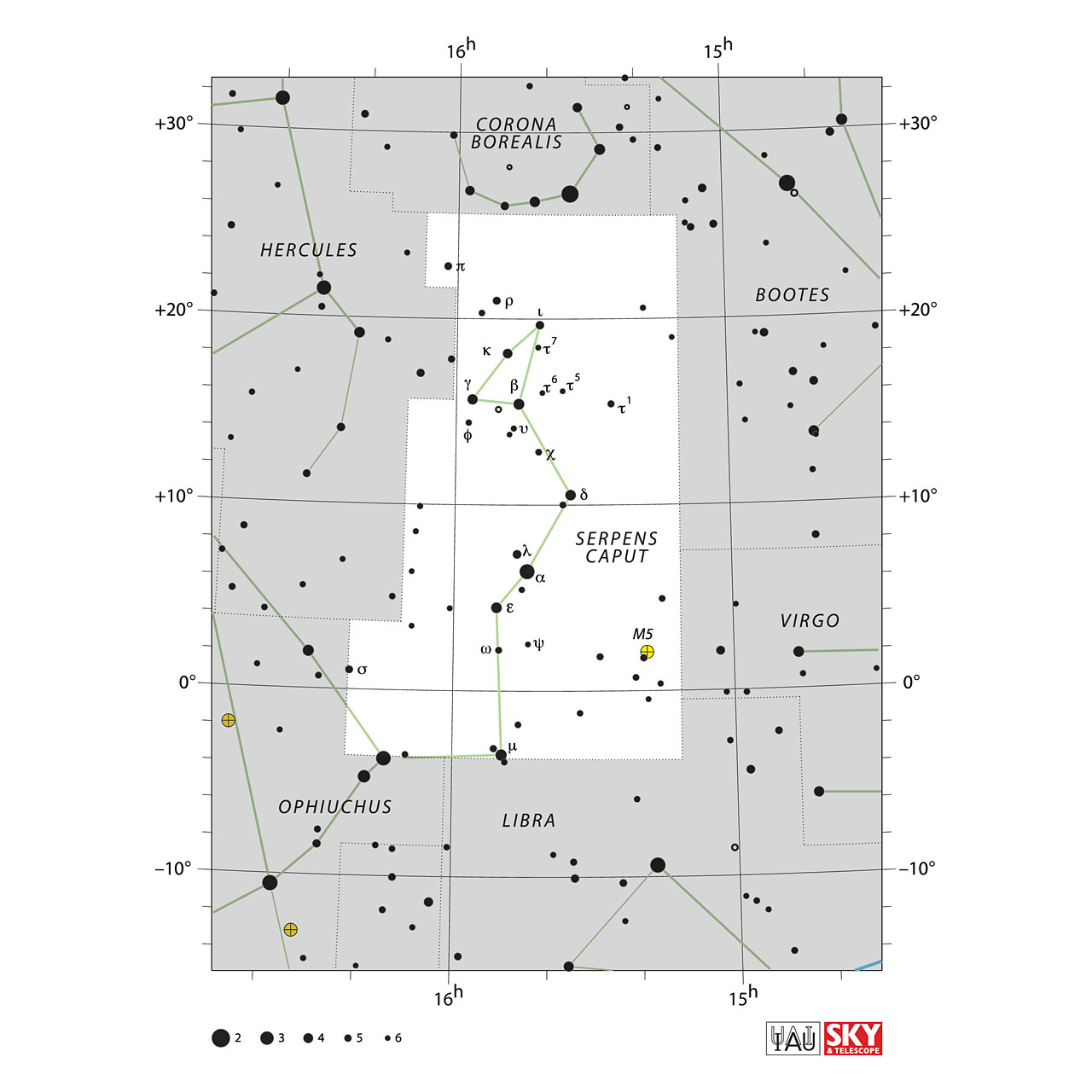Serpens Caput


Serpens is a constellation of the northern hemisphere. One of the 48 constellations listed by the 2nd-century astronomer Ptolemy. Serpens is the only one of the 88 modern constellations to be split into two disconnected regions in the sky: Serpens Caput (the head) and Serpens Cauda (the tail). The constellation is also unusual in that it depends on another constellation for context; specifically, it is being held by the Serpent Bearer Ophiuchus.
When Eugène Delporte came to define the modern constellation boundaries in the 1920s, he faced the problem of how to separate the serpent and serpent-bearer into two separate constellations, and he opted to split the serpent into two parts.
Serpens is an equatorial constellation which appears highest in the evening sky in the months around June.
Both the head of the snake, Serpens Caput, and the tail of the snake, Serpens Cauda are represented by third and fourth magnitude stars
The head of the snake is well separated from the Milky Way, and contains no bright deep sky objects. The tail of the snake, however, not only lies close to the plane of the Milky Way, but also neighbors Sagittarius, the constellation which contains the galaxy’s center. The brightest star in Serpens Caput is the red giant star Alpha Serpentis, or Unukalhai, with an apparent magnitude of 2.63. Also located in Serpens Caput are the naked-eye globular cluster Messier 5 and the naked-eye variables R Serpentis and Tau4 Serpentis.
Serpens is not the only snake in the night sky, and neither is it the largest. The largest of all the constellations is Hydra, the water snake, which also has a smaller and fainter companion in the far-southern sky, Hydrus.
In Greek mythology, Serpens represents a snake held by the healer Asclepius. Represented in the sky by the constellation Ophiuchus, Asclepius once killed a snake, but the animal was subsequently resurrected after a second snake placed a revival herb on it before its death. As snakes shed their skin every year, they were known as the symbol of rebirth in ancient Greek society, and legend says Asclepius would revive dead humans using the same technique he witnessed. Although this is likely the logic for Serpens’ presence with Ophiuchus, the true reason is still not fully known. Sometimes, Serpens was depicted as coiling around Ophiuchus, but the majority of atlases showed Serpens passing either behind Ophiuchus’ body or between his legs.
In the Indian astronomy system, Serpens is undivided and is called ಸರ್ಪ (Sarpa).
Serpens Caput Contains
-
Stars
- Unukalhai (mag 2.6)
- μ-Ser (mag 3.5)
- β-Ser (mag 3.6)
- ε-Ser (mag 3.7)
- δ-Ser (mag 3.8)
- γ-Ser (mag 3.9)
- κ-Ser (mag 4.1)
- δ-Ser (mag 4.1)
- λ-Ser (mag 4.4)
- ι-Ser (mag 4.5)
- ρ-Ser (mag 4.7)
- π-Ser (mag 4.8)
- σ-Ser (mag 4.8)
- MQ Ser (mag 5.1)
- b-Ser (mag 5.1)
- HD (mag 5.1)
- 10-Ser (mag 5.2)
- τ¹-Ser (mag 5.2)
- ω-Ser (mag 5.2)
- 16-Ser (mag 5.3)
- χ-Ser (mag 5.3)
- 3-Ser (mag 5.3)
- A²-Ser (mag 5.4)
- HD 145206 (mag 5.4)
- 6-Ser (mag 5.4)
-
Open Clusters
- None
-
Globular Clusters
- Messier 5 (mag 5.7)
-
Galaxy
- NGC 5921 (mag 10.8)
- NGC 6027 (mag 11.3)
- NGC 5962 (mag 11.3)
- NGC 5970 (mag 11.4)
- NGC 6070 (mag 11.7)
- NGC 5964 (mag 11.8)
- NGC 5936 (mag 12.4)
- NGC 6012 (mag 12.4)
- NGC 6020 (mag 12.6)
- NGC 6051 (mag 13.0)
- NGC 5990 (mag 13.1)
- NGC 5937 (mag 13.1)
- NGC 5996 (mag 13.2)
- NGC 5994 (mag 13.2)
- NGC 6118 (mag 13.2)
- IC 1158 (mag 13.2)
- NGC 5980 (mag 13.3)
- NGC 5957 (mag 13.3)
- NGC 5956 (mag 13.3)
- NGC 5953 (mag 13.3)
- NGC 6010 (mag 13.3)
- NGC 6004 (mag 13.4)
- IC 1151 (mag 13.4)
- NGC 5984 (mag 13.5)
- NGC 5920 (mag 13.6)
View Serpens Caput in 3D 
Source: Wikipedia, in-the-sky.org
Image Courtesy: Sky&Telescope & IAU, Illustration Images linked from Urania's Mirror on Wikmedia Commons by Sidney Hall
Image Courtesy: Sky&Telescope & IAU, Illustration Images linked from Urania's Mirror on Wikmedia Commons by Sidney Hall
